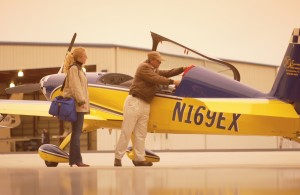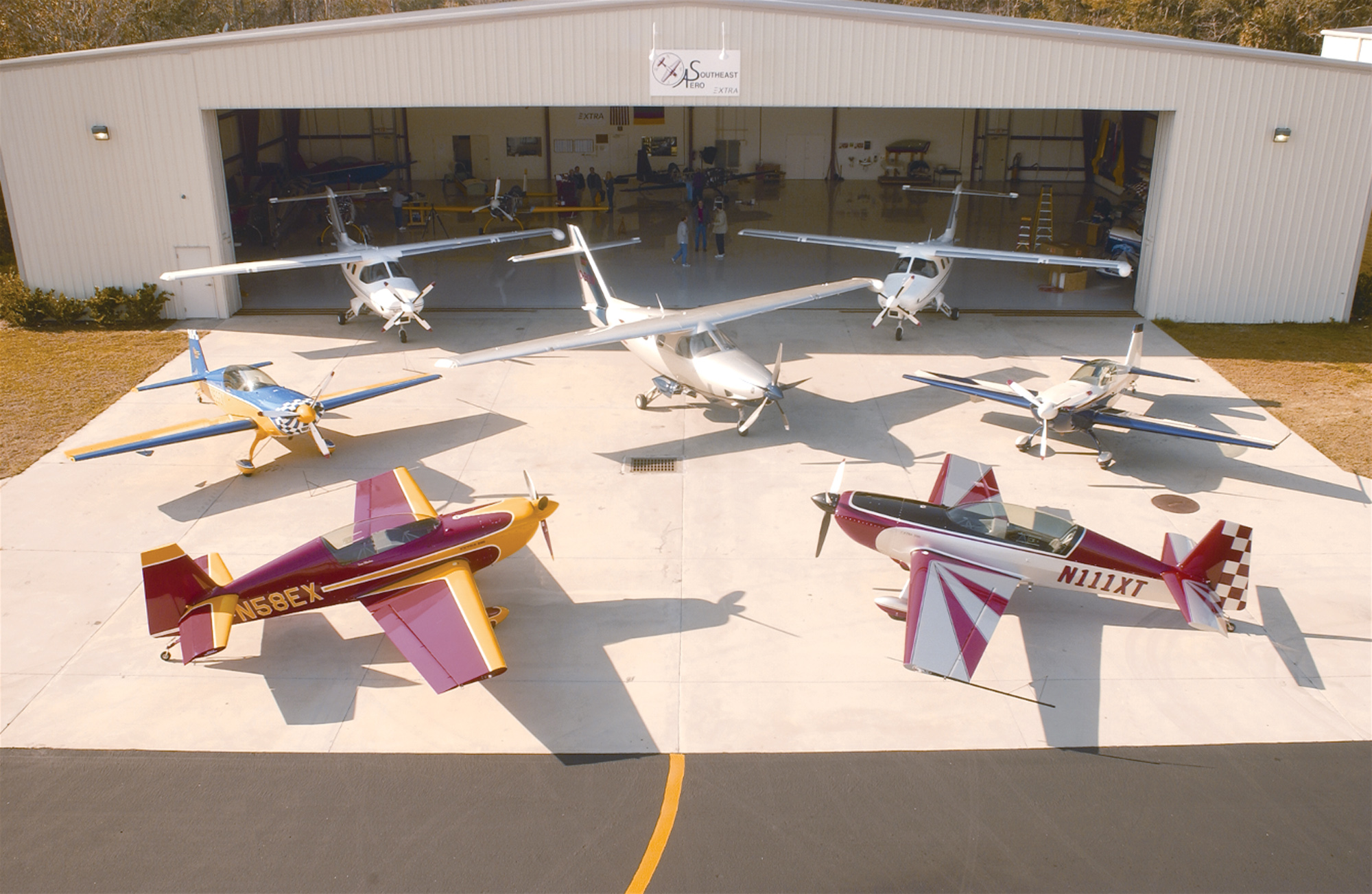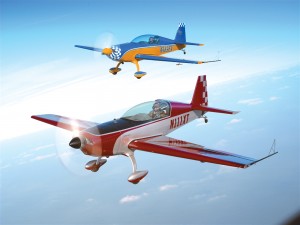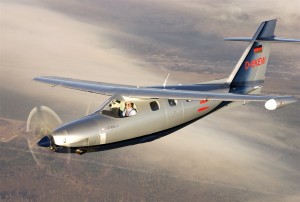By Lance Gurwell
Last year was an extraordinary one for German airplane manufacturer Extra Aircraft LLC and its founder, Walter Extra. The company, which celebrates its 25th anniversary this year, rebounded from a bankruptcy, and added an aerobatic two-seater and a six-passenger business-class airplane to a successful product line.
Extra’s business line continues with the production of a fleet of stellar aerobatic airplanes, including the new EA-300LP, and the company has begun manufacturing its certified six-passenger turbojet, the EA-500. To top off a magnificent year, Walter Extra also won a major aerobatic competition in Germany.
His peers consider 51-year-old Extra among the world’s most competitive aerobatic pilots, and his record as a spirited flyer supports those opinions. Many also consider him a design guru. To be fair, Extra does have help from his aeronautic engineers, and to its credit, this group isn’t afraid to do things differently than what has always been done.
Extra started flying as a teenager. By the 1980s, he had launched a one-man experimental operation that has since become an international success story. Extra’s desire to be a top aerobatic pilot led him to design and build his own plane, then modify it until it met his standards and enabled him to start winning competitions.
Attending EAA AirVenture Oshkosh 1980 stimulated his motivation to build a better aerobatic plane. At the time, most westerners believed Leo Loudenslager’s Laser was the top aerobatic airplane. Extra liked the way the Laser looked and flew.
“We used to say, ‘If you want to hide your mistakes, fly a Pitts. If you want to demonstrate you don’t make mistakes, fly a Laser,'” Extra said.
After visiting Oshkosh, Extra went back to Germany convinced he could build a better airplane. Armed with a degree in mechanical engineering and already amassing wins at aerobatic competitions, he began designing and building. His unique background as both an engineer and an aerobatic pilot helped him as he began sketching out plans for his first airplane.
Extra liked the Laser’s clean lines, and he wanted the aircraft’s sleek look in his own design. But he was loath to copy the Laser, so the young engineer explored new theories in his work. He pushed the limits of standard aerodynamic rules, resulting in a wing design entirely unlike the Laser’s. As work progressed, his conversations often began with “What if…”
In 1981, Extra introduced his first creation, the Extra 230, to the world. A two-blade prop, spun by a four-cylinder engine generating 230 horsepower, propelled the plane. At first glance, the EA-230 looked very conventional, with a steel-tube fuselage and a pine wood wing spar.
“The wood for the wing spar had to be carefully selected and each piece was destruction-tested in order to assure the required material properties,” Extra recalled.
He said the aircraft performed much like he expected it would. The basic 230 design was a good one. Company spokesperson Jennifer Hamilton said that while there have been many improvements under the skin, “very little has ever been changed from the original design.”
Soon, the 230 was winning competitions around the world and earned a reputation for its superb handling, ease of flying, performance and reliability.
“When I started flying, competition people were used to flying for one hour and then having to work on their planes for five hours,” said Extra. “I think I’ve contributed to turning this around and even improving it to normal maintenance standards.”
Before long, pilots started wanting what they always want–more power. Extra changed the engine to a six-cylinder, 290-horsepower Lycoming, and modified the airframe for the heavier motor and additional stress from the more powerful engine.
“One thing you have to understand about aerobatics is that power is never enough,” said Extra.

The Extra 300LP displays its beauty and graceful lines as its pilot enjoys some non-competition stick time. Also evident is the expansive and unobstructed cockpit view.
The new plane, the Extra 260, soon became known for its speed and handling, and helped Extra, and subsequently Patty Wagstaff, win respective national titles. The plane was such a success that one is on display at the Smithsonian’s Air and Space Museum.
Wagstaff started her aerobatic career in 1986. Although now retired from competition, she still burns up the sky in her Extra 300S at air shows worldwide.
“Other than being great performers, the Extras are very well built,” she said from her Florida office. “You don’t have to worry about the structural integrity of the plane.”
Wagstaff believes Extra’s status as an excellent aerobatic pilot himself gives him great insight when it comes to designing stunt planes.
“Walter’s a visionary,” she said. “He’s brilliant and charming, and he’s a young man, even though he’s been doing this a long time.”
Wagstaff, a talented horsewoman who enjoys jumping her horses competitively and also likes to ride her motorcycle, is a six-time member of the U.S. Aerobatic Team. She’s won the gold, silver and bronze medals in Olympic-level international aerobatic competition. Additionally, she was the first woman to win the title of U.S. National Aerobatic Champion, and is one of few people to win the title three times.
Carbon fiber key to strength, lightness
As time passed, Extra continued improving on his designs and his airplanes continued winning competitions. Less than a year after unveiling the 260 prototype, Extra Aircraft developed its first two-place aircraft, the EA-300. Because it was a two-seater, it was important to find ways to lighten the plane without sacrificing its aerobatic integrity. Extra had already made limited use of carbon fiber in his earlier aircraft, and it would play a major role in models to come.
He continued to study the use of carbon-fiber materials, commonly used in German-built gliders. As he started delving deeper into its properties and uses, he soon realized that using carbon fiber for spars offered lighter weight, more strength and higher stress values than pine. Additionally, each spar had the same properties as the one before, cutting production and testing times.
He first made extensive use of carbon fiber in his second prototype, the EA-260. The material was used in the empennage, and later the ailerons were made from carbon fiber. The fiber was used in numerous ways on the EA-300 series.
“It was only logical to use carbon-fiber composite in its design,” said Extra.
The 300 was a huge success, with three pilots flying it in the 1988 World Aerobatic Championship. As the 300 series evolved, carbon fiber was used more extensively. In addition to the wing and empennage, carbon fiber was also used in some nonstructural parts of the plane.
The Extra 300, 300L and 300S are the only certified aircraft in the unlimited aerobatic category qualified to plus or minus 10 Gs. In this year’s Red Bull Air Races, held in San Francisco, six out of the 10 pilots flew Extras in the competition.

Extra’s aerobatic planes aren’t just for competition. Ease of handling and comfortable seating makes a cross-country trip for two twice as much fun.
“Our engineers specifically designed the latest model with the competitive and performance pilot in mind,” Extra President Ken Weaver said of the EA-300LP. “We’ve created a package that gives pilots a distinct advantage by redesigning a number of aerodynamic features and weight-saving production processes.”
Carbon fiber was also used extensively in Extra’s latest competition plane, the EA-300LP.
“We’re extremely excited about this model,” Weaver said. “We pride ourselves on building the best planes in this category. The EA-300LP is our latest success.”
Enhancements on the EA-300LP are many, but some of the most notable include a redesign of the plane’s cowling to improve engine airflow. The aircraft also benefits from more extensive use of carbon-fiber honeycomb composite used in the cowling. A glass composite is used in the present Extra 300 lineup. Combined with carbon honeycomb fuselage shells, fairings, wheels and a titanium firewall, the EA-300LP provides pilots with superior and safe performance in the extreme G-force environment of unlimited-category flight.
Other improvements in the 300LP include a lightweight oil-cooling system, carbon-fiber instrument panel and lightweight avionics package. The changes save pilots about 30 pounds, which can make a substantial performance improvement.
Business aircraft, piston or turbojet engine
About 400 Extra aerobatic planes are flying worldwide, but the company’s commuter line is also making competitors and customers take notice. When the company decided to get into the business aircraft market, the EA-400 came first. The six-cylinder piston aircraft seats a pilot and five passengers.
But the company’s flagship model is the recently certified EA-500, which also seats six. Essentially the same airplane as the EA-400, the 500 sports a 450-hp Rolls Royce turbojet engine weighing just 205 pounds. The futuristic-looking plane has a high wing; the pilot seats are forward of the wing, providing an impressive range of vision.
“The high-wing design of these planes not only optimizes the aerodynamic efficiency and allows for generous cabin space, but also provides stability in flight,” said Extra.
The EA-500 is pressurized, has a ceiling of 25,000 feet and can fly more than 1,500 nautical miles without refueling.
Jeff Puckett, owner of USAero–Colorado, Extra’s distributor for the western half of North America, recently had an opportunity to fly the EA-500, with Extra as his copilot.
“Walter Extra is an incredibly bright and gracious gentleman,” Puckett said. “The EA-500 is such an incredible airplane; it’s beautifully built and it flies like a dream. It’s also incredibly fuel-efficient. Ask anyone who’s flown it and they’ll tell you how smooth it flies.”

An impressive view of the five-blade prop and cowling of Extra’s pressurized turboprop multi-passenger plane. The EA-500 carries five passengers and the pilot.
Puckett sells 10 to 12 EA-300 models annually. Presently the EA-400 and EA-500 are available only through direct factory order.
“I’m sure that at some point, dealers will be able to sell them,” Puckett said. “As you can imagine, selling aerobatic planes is a niche market.”
That naturally limits the number of Extras he can sell. Puckett is looking forward to having the 400 and 500 as part of his marketing stable.
The 400 and 500 are the only aircraft in their class for which the latest international dynamic safety certification requirements have been fully met. The EA-500 is proving to be strong competition for the likes of other single-engine turboprops such as the Cessna Grand Caravan, Piper Meridian and the Raytheon King Air C90B.
“It can also travel more than 1,600 nm, burning one-third less fuel and operating at one-third lower cost than its most efficient competitor,” said Weaver.
Compared to these aircraft, the EA-500 currently has the lowest cost per mile and per seat, he added.
In a test flight in October 2004, the EA-500 flew a nonstop, seven-hour flight with reserve fuel. The EA-500 flew from Santa Rosa, Calif., to Duluth, Minn., at 1,500 nautical miles, nonstop with two people, bags, tools and show displays. Extra Aircraft officials said that in order to achieve a range similar to the EA-500’s in another aircraft, operating costs would double; the EA-500 consumed an average of 20.4 gallons of fuel per hour during its trip.
“The trip further confirms that the EA-500 is an exceptionally flexible aircraft,” said Extra CEO Ken Keith. “It’s the only aircraft in its class and beyond that is capable of achieving this degree of operating efficiency.”
The $1.3 million business-class aircraft is already European Aviation Safety Agency-certified and beats competition in a number of ongoing expenditures, such as operating and insurance costs.
Extra Aircraft’s American offices are in Lancaster, Pa., with home offices in Germany. The company became U.S.-owned and operated in 2003. Soon, Extra Aircraft is expected to announce the location of its new North American worldwide headquarters.
For additional information about Extra Aircraft, LLC, visit [http://www.extraaircraft.com] or call 615-346-9564.















